Fungal Root, Leaf, and Stem Diseases of Wheat
May 15, 2025
- Some fungi begin as root and crown rot which spreads to above-ground plant material while other fungi start as foliar infections and affect head and grain development after flowering.
- Fungi reproduction and survival is often complex with different spores for sexual and asexual reproduction.
- Cultural practices to help manage fungal disease include selecting wheat varieties with tolerance to the race of fungi in the field and keeping a balanced fertility program.
- Registered fungicides may offer a positive return on investment in scenarios with good grain yield potential and high disease pressure.
Rusts
Rust species are biotrophic fungi, keeping their host cells alive while taking nutrients from them and surrounding cells. They are also obligate pathogens that not only require a host, but a specific host, to complete their lifecycle. Reproduction involves multiple spore stages, alternate hosts, and sexual and asexual sporulation.
Causes of Rust1
Rust diseases can develop rapidly in appropriate temperatures and prolonged periods of leaf wetness throughout the growing season. Each species of rust fungi thrives under a slightly different temperature range.
Leaf rust (Puccinia triticina) – temperatures favoring infection are between 59 to 71 °F with disease spreading until temperatures reach greater than 80 °F.
Wheat stem rust (Puccinia graminis f. sp. tritici) – temperatures favoring this disease are between 65 to 85 °F, but infection can develop at temperatures as low as 59 °F and as high as 104 °F.
Stripe Rust (Puccinia striiformis f. sp. tritici) – temperatures between 50 and 59 °F favor the disease; however, infections stop at temperatures greater than 70 °F.
Symptoms
The symptoms typically noticed on wheat – and for what the infection is named for – are rust-colored uredospores produced as fungi erupt through the leaf surface.
Stripe (yellow) rust (P. striiformis f. sp. tritici) is characterized by linear rows of bright yellow-orange pustules that follow leaf veins.
For more information on Stripe Rust click Understanding Stripe Rust in Wheat
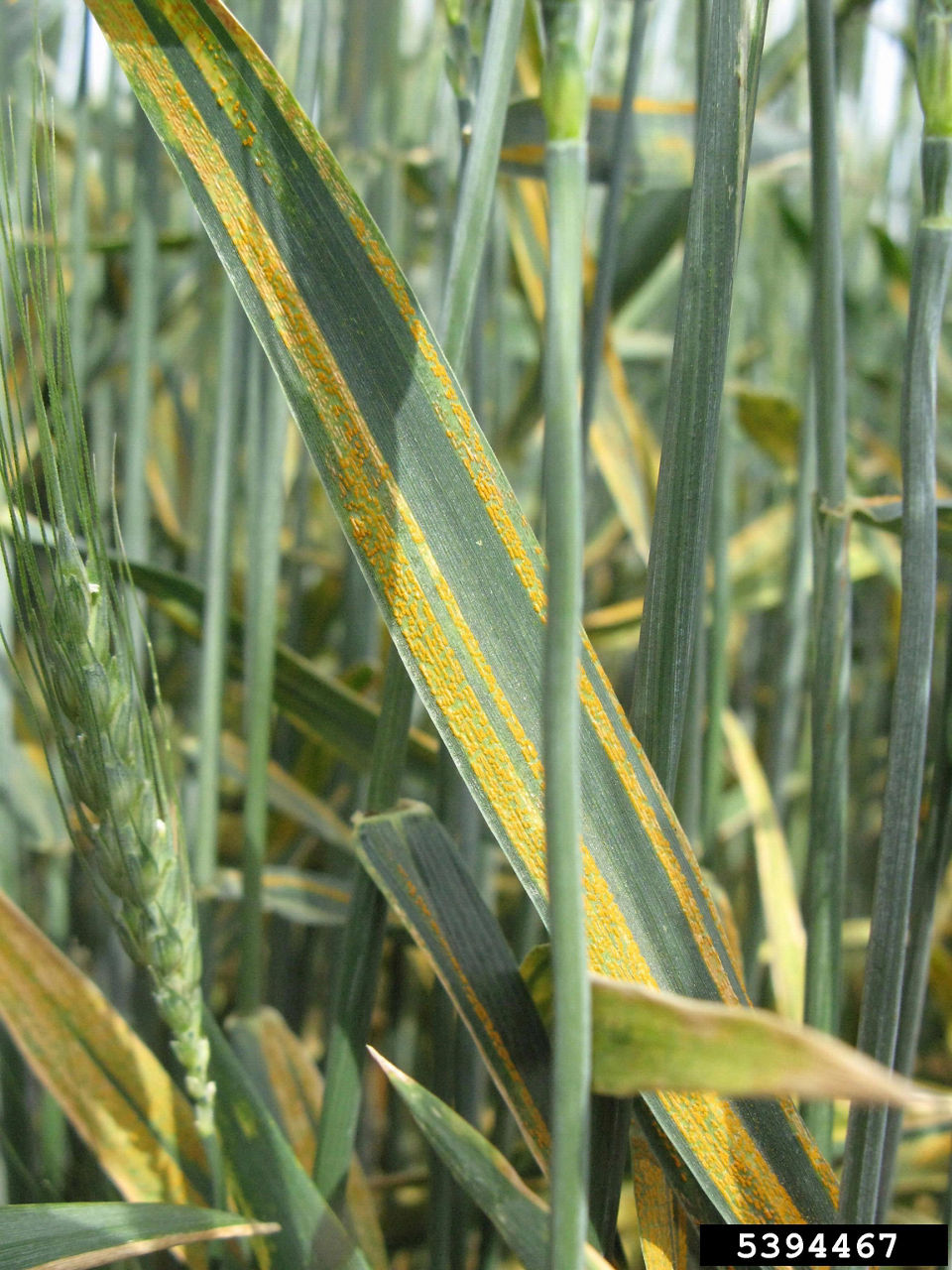
Leaf rust (P. triticina) small, randomly distributed orange-brown lesions on upper leaf surfaces and leaf sheaths that do not coalesce are indicative of leaf rust.
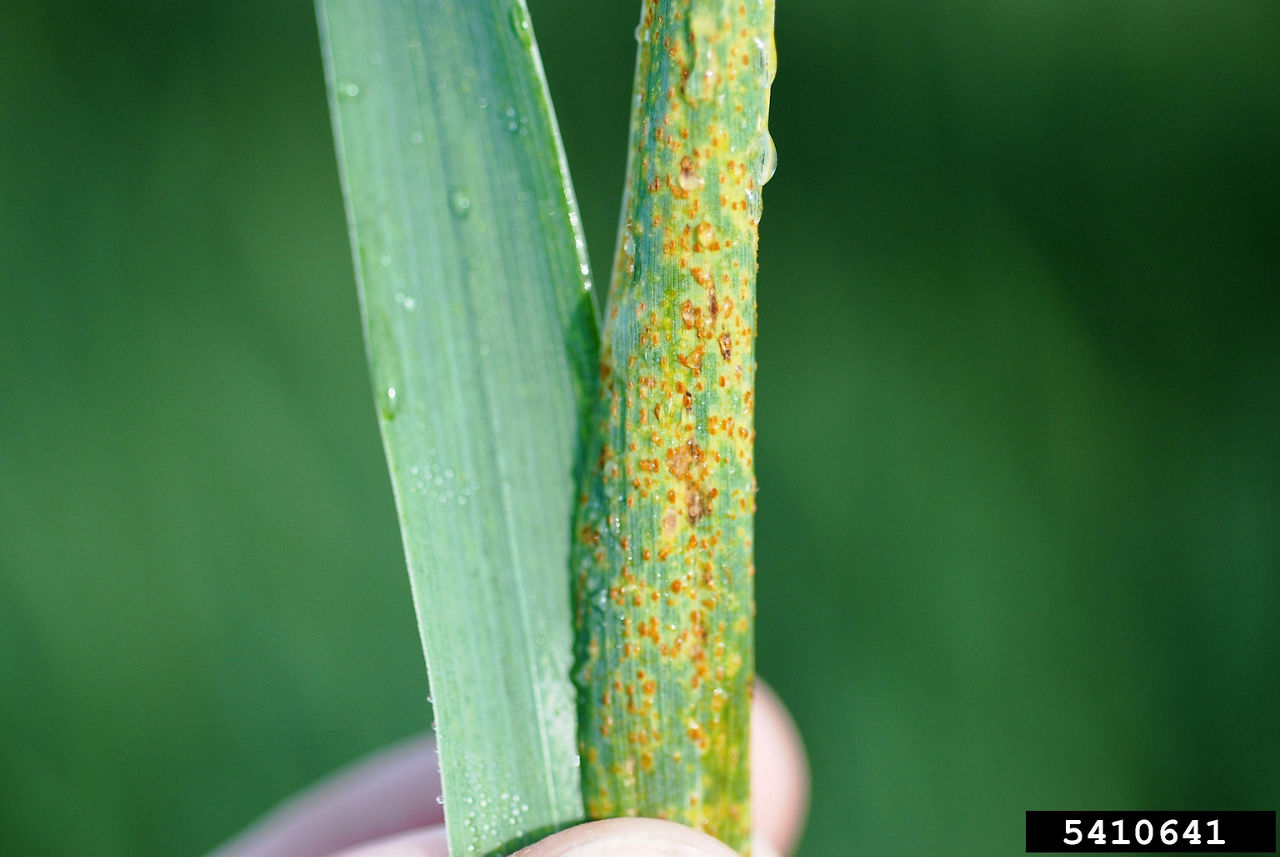
Stem rust (P. graminis f.sp. tritici) pustules are larger, dark reddish-brown and can be found on upper and lower leaf surfaces, stems, and spikes. Initially the lesions will be scattered but may coalesce in heavy infestations.
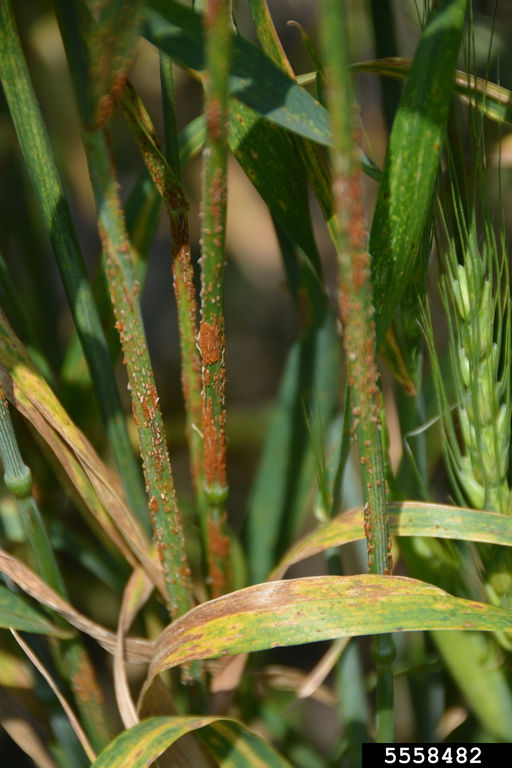
Effect on Yield
In 2024, the reported yield losses in the United States from stripe, leaf, and stem rust were 36,960,000; 7,652,000; and 1,169,000 bushels, respectively.2 Yield losses depend on rust severity and growth stage of wheat (Table 1). Severe losses can occur due to significant loss of tissue resulting in a reduction in kernels, test weight, and grain quality as well as lodging.
Table 1. Percent yield loss regarding severity of leaf rust and wheat growth stage.3

Management of Rust Diseases
Management includes planting resistant products where available and the use of foliar fungicides applied before an infection becomes severe. Bayer fungicides that are registered for control of Puccinia spp. include Absolute® Maxx fungicide, Delaro® Complete fungicide, Delaro® 325 SC fungicide, Proline® 480 SC fungicide, Prosaro® 421 SC fungicide, Prosaro® PRO fungicide, Stratego® fungicide, and Stratego® YLD fungicide.
Frequent reproduction in rust fungi results in constantly recombining genetics. Therefore, disease resistance in a wheat variety is dependent on having a race of rust that has not overcome the defense of the planted wheat variety. Additionally, a race of rust can become resistant to a fungicide class after repeated use increases selection pressure for resistant alleles in that fungi race.
Powdery Mildew4
Causes of Powdery Mildew
Powdery mildew is a fungal infection caused by Blumeria graminis f. sp. tritici. The disease is favored by temperatures between 59 and 71 °F and high relative humidity (near 100%); free moisture is not required for this disease to develop. Wheat is most susceptible to infection during periods of rapid growth – stem elongation and heading.
Symptoms
A distinctive symptom is the powdery white growth beginning on lower leaves. This fungal growth turns gray to brown and can spread to stems and heads. Tiny black dots (cleistothecia) can be found within the older gray fungal growth.
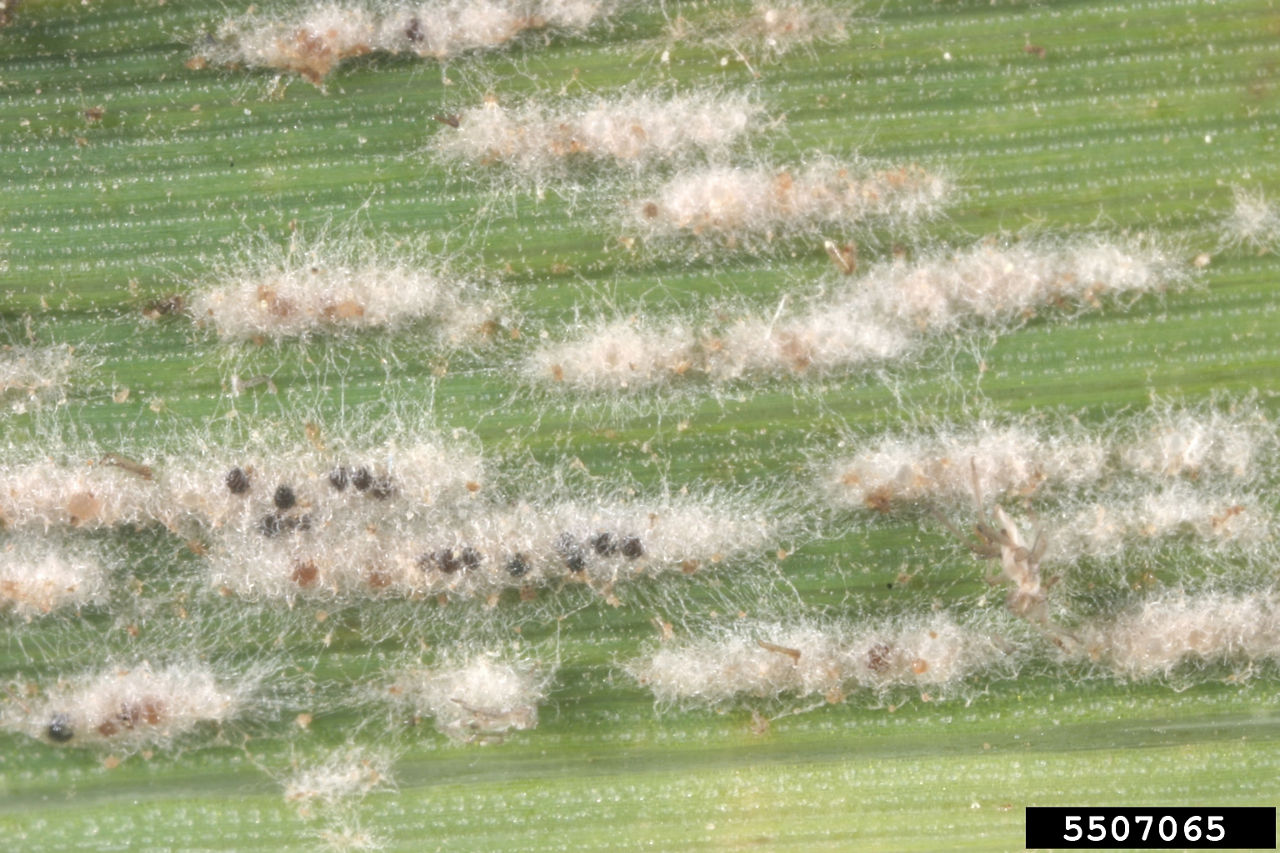
Effect on Wheat Yield
Infected plants have reduced head numbers with lighter kernel weight. Susceptible wheat varieties, and powdery mildew infection during the booting stage can lead to 40 to 45 percent wheat yield loss.4,5 Severe infection on the flag leaf as crops reach heading stage are expected to cause greater losses of yield potential. In 2024, powdery mildew was ranked the fourth most damaging wheat diseases for the mid-Atlantic United States.2
Management
- Management includes planting cultivars with current resistance to powdery mildew races in the field.
- Balance nitrogen fertility, especially monitor fields with greater than 70 lb nitrogen/acre.
- Reduce over-wintering spores with crop rotation, residue management, and control of volunteer wheat.
- Fungicides registered for control of powdery mildew include Absolute® 500 SC fungicide, Absolute® Maxx fungicide, Delaro® 325 SC fungicide, Proline® fungicide, Prosaro® fungicide, Prosaro® PRO 400 fungicide, Stratego® fungicide, and Stratego® YLD fungicide. Consider commodity prices for grains, susceptibility of the growing variety, and disease pressure before applying fungicides. It is recommended to keep the two uppermost leaves free of disease during grain fill.
Take-all
Take-all is the root, crown and basal stem rot caused by the soil-borne fungus Gaeumannomyces graminis var. tritici. This disease is favored by cool weather temperatures of 54 to 64 °F.6 It is more common in poorly drained neutral to alkaline soils with poor nitrogen, phosphorous, and manganese fertility.6,7 Wheat roots coming into contact with the G. graminis var. tritici become infected.
Symptoms
Symptoms can appear in fall or early spring but are most observed during heading. Take-all disease is known for reduced tillering, lack of heading, bleached or empty heads, shriveled kernels, bleached plants dying prematurely. At the soil level, the presented symptoms include rotting roots, blackened crown, and lower stem tissue with shiny, dark brown to black mycelia. Darkened lower stems are diagnostic for take-all disease.
)
)
Effect on Wheat Yield
The disease can infect entire wheat stands, hence the name. Globally, take-all is considered the greatest damaging root disease in wheat.8 The United Kingdom reported annual yield losses between 5 and 20 percent with about half of their wheat crops being affected by take-all each year.
Management
Management includes at least a one-year break from small-seeded cereal crops with control of grassy weed hosts, adequate fertility, and later fall planting of wheat. Although disease pressure can be reduced, some inoculum remains, and the disease can survive on non-symptomatic host plants.
Fungicides have been inconsistent in controlling take-all disease. Applied as a seed treatment, some fungicides (fluquinconazole and silthiofam) effectively protect seedlings from G. graminis var. tritici during the seedling stage.8 However, not all isolates of the fungi are susceptible to these fungicides; additionally, roots can still become infected after the seedling stage.
Septoria tritici blotch
Causes of Septoria tritici blotch
Septoria tritici blotch is caused by the fungal pathogen Zymoseptoria tritici. The pathogen survives on wheat residue, wind or rain drops spread it during wheat-growing seasons with favorable conditions. This disease is favored by cool, wet weather (50 to 68 °F and 24 hours of prolonged wetness).9
Symptoms
This disease first infects lower leaves; however, symptoms are commonly discovered after flag leaf emergence. Symptoms are chlorotic (yellow) flecks growing into irregular brown lesions within leaf veins. Gray to brown gelatinous pycnidia pepper the lesions at later stages.
)
Effect on Wheat Yield
Z. tritici causes size and quality reductions in grain. A severe case of the disease can cause 30 to 50 percent yield loss.5 Epidemics of this disease can occur where lower temperatures prevail with humid weather.
Management
Because Z. tritici can survive several years in a field, management should be aimed at reducing disease severity in fields rather than eradication. Management strategies include planting resistant cultivars, using pathogen-free seed and/or fungicide seed treatment, and crop rotation with broadleaf crops.
Early and/or late-season fungicides can be used effectively on septoria tritici blotch. It is common practice in the Northern Plains to apply tank mixed herbicide and fungicide at the four- to six-leaf growth stage in wheat.9 Fungicides that are registered for control of Septoria tritici blotch include Absolute® 500 SC fungicide, Absolute® Maxx fungicide, Delaro® 325 SC fungicide, Proline® 480 fungicide, Prosaro ® 421 fungicide, Prosaro® PRO fungicide, Stratego® fungicide, and Stratego® YLD fungicide.
Stagonospora nodorum Blotch
Causes
Stagonospora nodorum blotch is caused by the fungal pathogen Parastagonospora nodorum. This disease is favored by warm, wet weather (68 to 81 °F and 12 to 18 hours of wetness).9 P. nodorum survives on plant residue or infected seed and is spread by water splash. Host-selective toxins produced by the pathogen help the infection further by inducing necrosis and chlorosis.
Symptoms
Symptoms are similar to Septoria tritici blotch though this disease presents later in the season from heading through dough development. Small chlorotic (yellow) lesions develop on lower leaves becoming red brown with a gray-brown center. Pycnidia appear in the lesions and differentiate this disease from tan spot. Wet weather during the post-flowering stages can cause dark brown or purple lesions to form known as “glume blotch”.
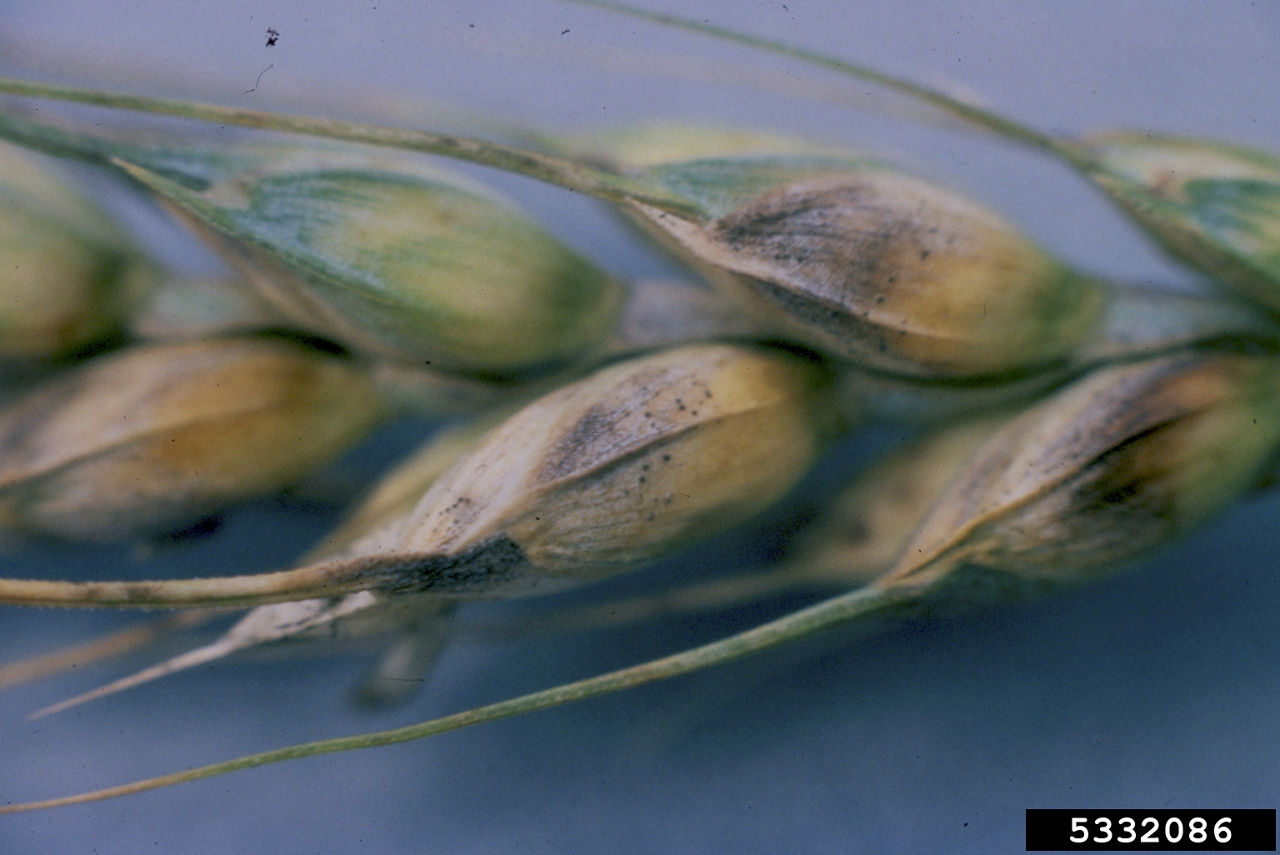
Effects on Wheat Yield
Severe glume blotch causes lightweight, shriveled kernels. In the United States, an estimated 4,813,000 bushels were lost from Stagonospora nodorum blotch in 2024.2 Stagonospora nodorum blotch often forms a disease complex with Septoria tritici blotch and tan spot. These diseases have can reduce grain test weight and yield by 50 percent.9
Management
Management strategies include planting resistant cultivars, using pathogen-free seed and/or fungicide seed treatment, crop rotation to reduce inoculum of pathogens in future wheat crops, and early and/or late season fungicides. Fungicides registered for control of Stagonospora nodorum blotch include Absolute® 500 SC fungicide, Absolute® Maxx fungicide, Delaro® 325 SC fungicide, Proline® 480 SC fungicide, Prosaro ® 421 SC fungicide, Prosaro® PRO fungicide, Stratego® fungicide, and Stratego® YLD fungicide.
Tan Spot
Causes
Tan Spot is caused by fungal pathogen Pyrenophora tritici-repentis. Residue-borne spores are dispersed by wind. Infection can occur in a wide range of temperatures and is best spread during wet periods of 24 hours or more.9 As such, it can impact wheat through most of the season from stem elongation to ripening.
Symptoms
Symptoms first appear as small (1/8 to 1/2 inch long by 1/18 to 1/16 inch wide) oval to diamond-shaped spots on the leaves. These spots grow larger and become tan spots. Pycnidia is not a symptom of this disease though these spots may be found with a dark brown spot in the middle. Commonly, a yellow halo occurs around the tan spot. Kernels can also be infected developing a reddish seed coat.

Effects on Yield in Wheat
A yield loss of 5 to 10 percent typically occurs from tan spot with a 50 percent yield loss possible when environmental conditions favor the disease.5 Infected grain has low germination, ‘red smudge’ from colored spores, and black points. Grain market discounts can result when kernels are infected.
Management
Management strategies include planting resistant cultivars, crop rotation to reduce inoculum of pathogens in future wheat crops, and in-season fungicides. A two to six bu/acre yield benefit has been reported from using early season fungicide applications to control tan spot when high disease pressure is forecasted.9 Fungicides registered for control of tan spot include Absolute® 500 SC fungicide, Absolute® Maxx fungicide, Delaro® 325 SC fungicide, Proline® 480 fungicide, Prosaro ® 421 fungicide, Prosaro® PRO fungicide, Stratego® fungicide, and Stratego® YLD fungicide.
Sources
1Marsalis, M.A. and Goldberg, N.P. 2016. Leaf, stem, and stripe rust diseases of wheat. New Mexico State University. Guide A-415.
2Anderson, N., Sisson, A., Turkington, K., et al. 2025. Wheat disease loss estimates from the United States and Canada – 2024. (D. Mueller and K. Wise, reviewers). doi.org/10.31274/cpn-20250324-0
3Hunger, B. 2019. Foliar fungicides and wheat production in Oklahoma. Oklahoma State University. CR-7668. https://extension.okstate.edu/fact-sheets/foliar-fungicides-and-wheat-production-in-oklahoma-march-2016.html
4 Salgado, J.D., Paul, P.A. Powdery mildew of wheat. Ohio State University Extension. https://ohioline.osu.edu/factsheet/plpath-cer-11#:~:text=Powdery%20Mildew%20of%20Wheat%201%20Symptoms.%20Powdery%20mildew,elongation%20and%20heading%20growth%20stages.%203%20Management.%20.
5Kayim, M., Nawaz, H., and Alsalmo, A. 2022. Fungal diseases of wheat. (M.u.R. Ansari, ed). DOI: 10.5772/intechopen.102661
6Hershman, D.E., Bachi, P.R. 2010. Take-all of wheat PPFS-AG-SG-01. University of Kentucky Extension. https://plantpathology.ca.uky.edu/.
72019. Take-all of wheat. Crop Protection Network. https://cropprotectionnetwork.org/encyclopedia/take-all-of-wheat
8Palma-Guerrero, J., Chancellor, T., Spong, J., Canning, G., Hammond, J., McMillan, V.E., Hammond-Kosack, K.E. 2021. Take-all disease: new insights into an important wheat root pathogen. Trends in Plant Science. 26(8): 836-848. https://www.cell.com/trends/plant-science/fulltext/S1360-1385(21)00038-8?_returnURL=https%3A%2F%2Flinkinghub.elsevier.com%2Fretrieve%2Fpii%2FS1360138521000388%3Fshowall%3Dtrue
9Friskop, A., Liu, Z. 2016. Fungal leaf spot diseases of wheat: tan spot, Septoria/stagonospora nodorum blotch and Septoria tritici blotch. PP1249. North Dakota State University Extension. https://www.ag.ndsu.edu/publications/crops/fungal-leaf-spot-diseases-of-wheat-tan-spot-septoria-stagonospora-nodorum-blotch-and-septoria-tritici-blotch.
Sources verified 4/3/2025. 1711_504027